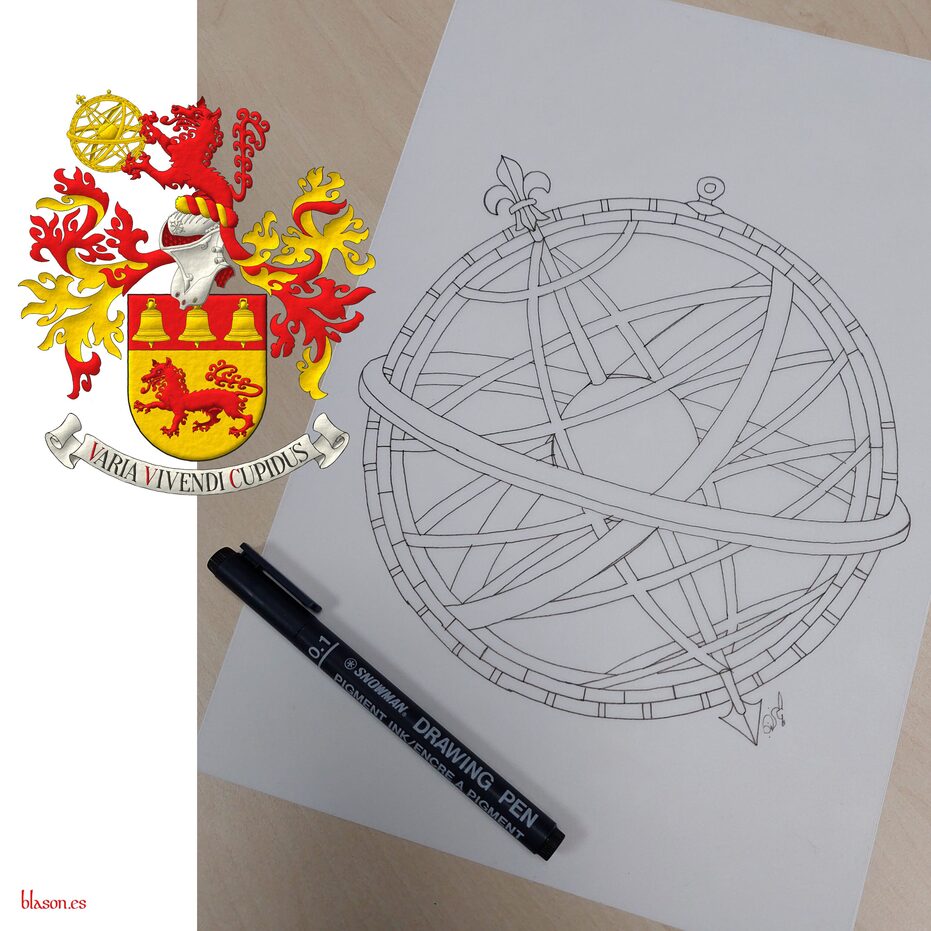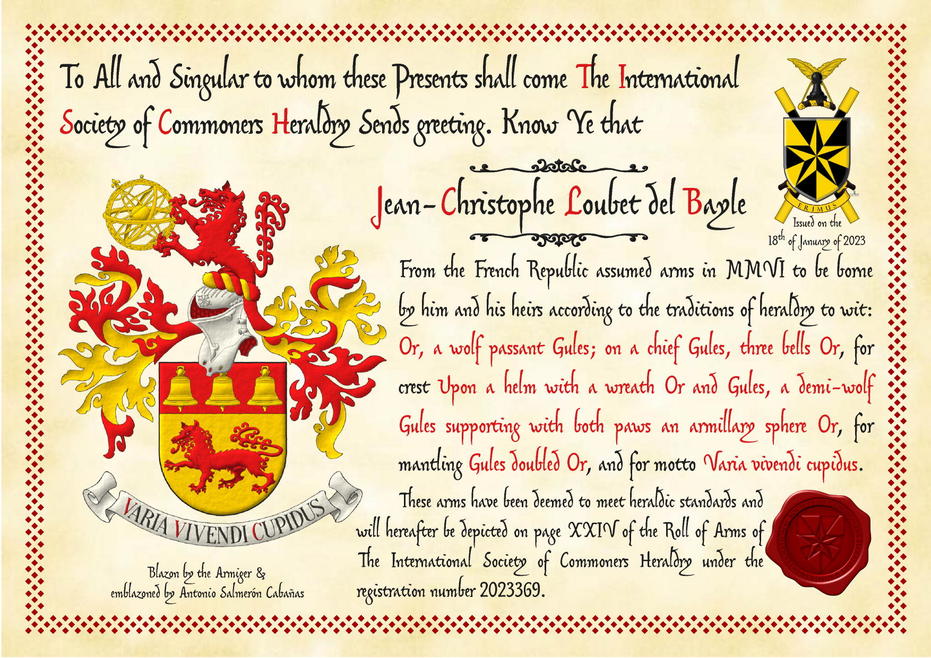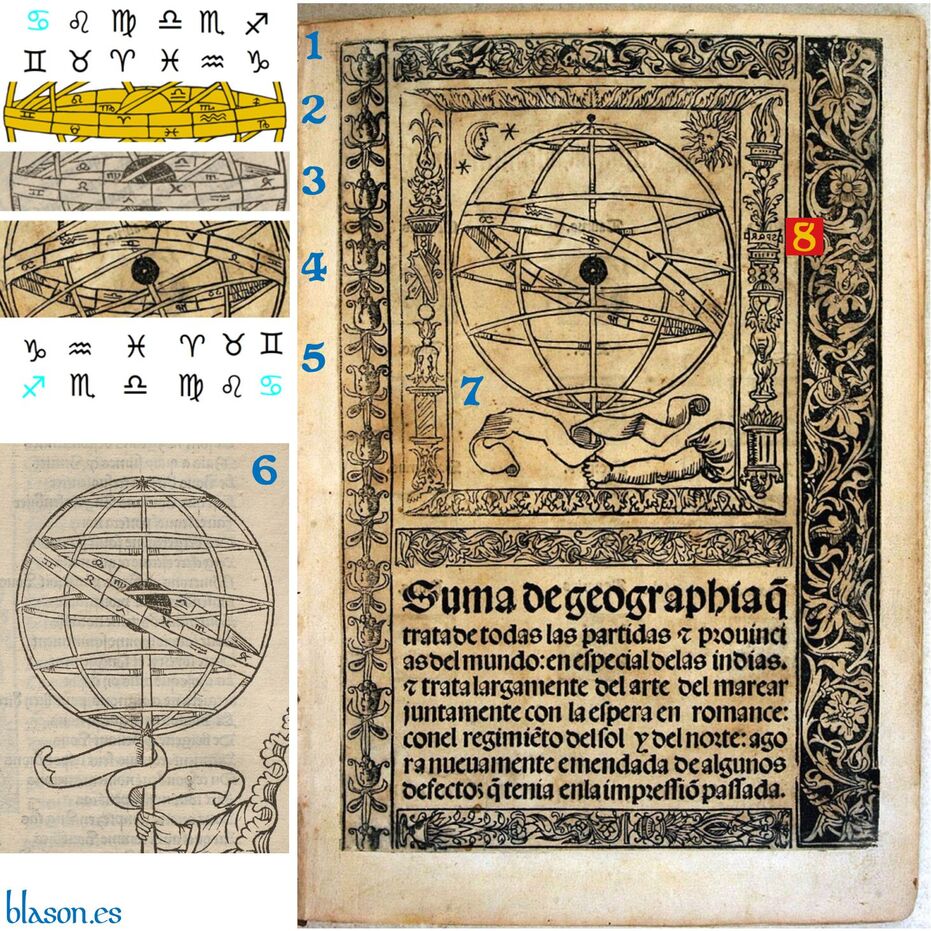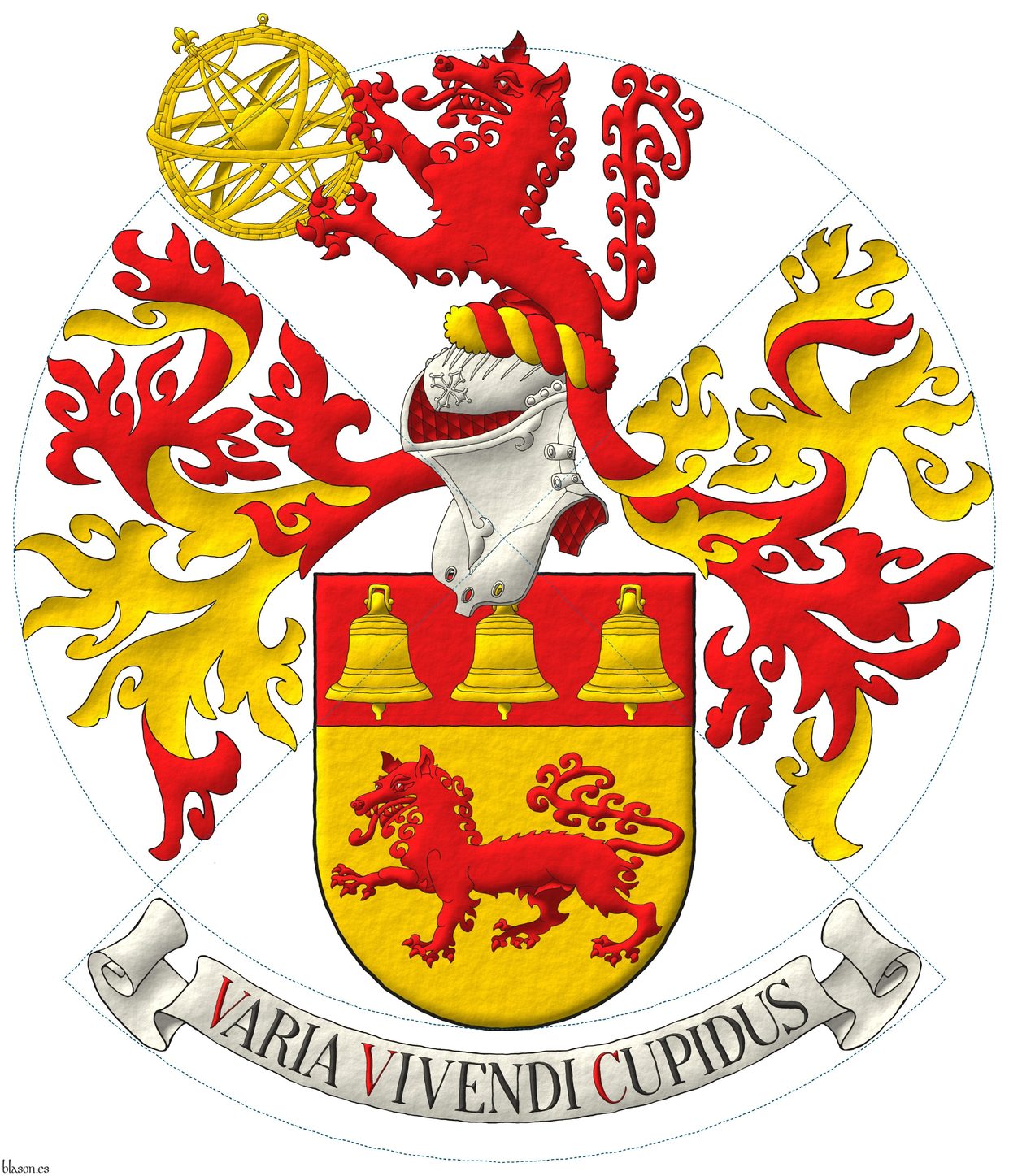Armillary sphere

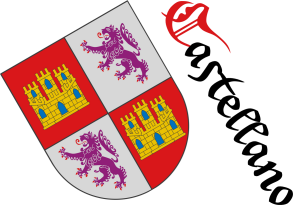
Arms of Jean-Christophe Loubet del Bayle with an armillary sphere drawn by me
Or, a wolf passant Gules; on a chief Gules, three bells Or. Crest: Upon a helm with a wreath Or and Gules, a demi-wolf Gules supporting with both paws an armillary sphere Or. Mantling: Gules doubled Or. Motto: «Varia vivendi cupidus».
The coat of arms of Jean-Christophe Loubet del Bayle. The image combines a photograph of a drawing of an armillary sphere along with his arms, both painted by me.
Blazon keywords: Or, Gules, One, Three, Wolf, Passant, Chief, Bell, Crest, Upon (wreath), Helm, Wreath, Demi, Supporting, Paw, Armillary sphere, Mantling, Motto and Scroll.
Style keywords: Outlined in sable, Illuminated and Semi-circular.
Classification: Personal, Interpreted, Boa, Hand-drawn, Collage and Photographic.
Bearer: Loubet del Bayle, Jean-Christophe.


Commoners' certification Jean-Christophe Loubet del Bayle
Or, a wolf passant Gules; on a chief Gules, three bells Or. Crest: Upon a helm with a wreath Or and Gules, a demi-wolf Gules supporting with both paws an armillary sphere Or. Mantling: Gules doubled Or. Motto: «Varia vivendi cupidus».
The Commoners' Certification of Arms for Jean-Christophe Loubet del Bayle with his arms designed by him emblazoned by me.
Blazon keywords: Or, Gules, One, Three, Wolf, Passant, Chief, Bell, Crest, Upon (wreath), Helm, Wreath, Demi, Supporting, Paw, Armillary sphere, Mantling and Motto.
Style keywords: Outlined in sable, Illuminated and Semi-circular.
Classification: Personal, Interpreted, Boa, Certification and Heraldic document.
Bearer: Loubet del Bayle, Jean-Christophe.


![Ver [Fernández de Enciso, M.; 1519] en referencias bibliográficas. Libro abierto, hojas de plata, filo de oro, guardas de gules, tapas de sable.](../css/Libro.Bibliografia.png)
Fernández de Enciso, M.; 1519
Martin Fernandez de Enciso, «Sum of Geography, which deals with all the parts and provinces of the world: especially the Indies. And deals extensively with the art of navigation, together with the sphere in the vernacular, with the regulation of the Sun and the North: newly made. With royal privilege.», 148 pages, House of Trade (Casa de la Contratación), Seville, 1519.
Preliminary note
Note that I try to use, even in these non-heraldic cases, the language of blazon, thus I speak of positions such as in chief, in base, dexter or sinister, arrangements such as in bend and in bend sinister and tinctures such as sable, azure or gules.
Zodiacal bands in armillary spheres: A comparative analysis of Marchant (1499) and Fernández de Enciso (1519) engravings
[Marchant, G.; 1499; page 15] and [Fernández de Enciso, M.; 1519; page 1] depict an armillary sphere with the zodiac signs, &Aries; Aries, &Taurus; Taurus, &Gemini; Gemini, &Cancer; Cancer, &Leo; Leo, &Virgo; Virgo, &Libra; Libra, &Scorpio; Scorpio, &Sagittarius; Sagittarius, &Capricorn; Capricorn, &Aquarius; Aquarius and &Pisces; Pisces, represented on a band around the sphere. I have compared both zodiacal bands by means of the composition of the previous image.
In this image I have made there are:
- In the 3rd row, the band of zodiac signs of the armillary sphere by [Marchant, G.; 1499].
- Above, in the 2nd row, the band of my interpretation of the same previous engraving.
- In chief, at the very top, in the 1st row, the zodiac signs in sable and azure, with those not visible, in the order of [Marchant, G.; 1499], that is, as read by the reader of the book, from his frontal perspective of the engraving, in counterclockwise direction, &Gemini;, &Taurus;, &Aries;, &Pisces;, &Aquarius;, &Capricorn;, &Sagittarius;, &Scorpio;, &Libra;, &Virgo;, &Leo; and &Cancer; which is not visible. Note that, for example, Taurus appears before Aries so the sequence is geocentric, that is, arranged from the point of view of an observer located at the center of the Earth, which is different from the book reader.
- Below, in the 4th row, the band of zodiac signs of the armillary sphere by [Fernández de Enciso, M.; 1519].
- In base, at the very bottom, in the 5th row, the zodiac signs in black and in cyan, with those not visible, in the order of [Fernández de Enciso, M.; 1519], that is, as read by the same reader of the book in counterclockwise direction, &Capricorn;, &Aquarius;, &Pisces;, &Aries;, &Taurus;, &Gemini;, &Cancer; which is not visible, &Leo;, &Virgo;, &Libra;, &Scorpio;, and &Sagittarius; which is also not visible. Note that in this case, for example, Aries appears before Taurus so the sequence is ecliptic, that is, from the point of view of an observer located in outer space, the point of view of the ecliptic sequence coinciding with the point of view of the book reader.
The 3 main differences observed are:
- [Marchant, G.; 1499], number 6 in the image, places at the top the zodiac signs that [Fernández de Enciso, M.; 1519], number 7 in the image, places at the bottom, as a curiosity it can be seen in my interpretation of [Marchant, G.; 1499] that for aesthetic reasons I placed at top and bottom the zodiac signs as [Fernández de Enciso, M.; 1519] does.
- They do not start in the same position, it is &Aries; Aries that has a more similar position in both but with one slot of difference.
- The signs in [Marchant, G.; 1499] and [Fernández de Enciso, M.; 1519] rotate in opposite directions.
The only important conceptual difference is the reverse rotation of the zodiac signs, that is, that [Marchant, G.; 1499] uses the geocentric sequence and [Fernández de Enciso, M.; 1519] uses the ecliptic sequence. In no case is it a printing error of an engraving in mirror, since neither of the two armillary spheres is engraved in mirror, as both have the zodiacal band in bend, and if they were engraved in mirror the zodiacal band would appear placed in bend sinister.
We could also study the few non-symmetrical signs that can be distinguished completely:
- For example, on the back side of the band of [Marchant, G.; 1499], &Scorpio; Scorpio has the scorpion’s stinger in the shape of an m pointing to sinister (the reader’s right), so it makes sense from the point of view of a geocentric observer.
- For example, on the back side of the band of [Fernández de Enciso, M.; 1519], &Leo; Leo seems to have the circle of its head to dexter (the reader’s left) and the curl of its tail to sinister (the left of a geocentric observer), while in &Scorpio; Scorpio, the stinger of the m-scorpion seems to point to dexter (the reader’s left) as if the sign were intended to be seen from the other side of the outside, piercing the band, so that the book reader sees the sign in mirror. Be that as it may, the arrangement of these 2 signs does not seem consistent with each other.
Although it is not a case of printing the engraving in mirror, such errors exist since, if we go beyond the armillary sphere of [Fernández de Enciso, M.; 1519] to study its outer decoration, we see that the SPQR, of «Senatus Populusque Romanus», is in mirror, I have marked it with a square of gules with the number 8 in the image, so that, although its armillary sphere is well printed, in the outer decoration the printer made a mistake and printed it the other way round.
Bibliographical reference of century XVI.
Classification: In black and white and Castilian language.
The author is Fernández de Enciso, Martín.
The following articles cite this bibliographic reference:
External links:
Internal resources: FernandezDeEncisoM1519.SumaDeGeographia.CatedraNaval.pdf in scanned PDF format at the Naval Chair, Spanish Navy, University of Murcia..


Jean-Christophe Loubet del Bayle, schema
Or, a wolf passant Gules; on a chief Gules, three bells Or. Crest: Upon a helm with a wreath Or and Gules, a demi-wolf Gules supporting with both paws an armillary sphere Or. Mantling: Gules doubled Or. Motto: «Varia vivendi cupidus».
The coat of arms of Jean-Christophe Loubet del Bayle designed by him emblazoned by me. The image shows the geometric structure used to arrange the heraldic elements in harmony.
Blazon keywords: Or, Gules, One, Three, Wolf, Passant, Chief, Bell, Crest, Upon (wreath), Helm, Wreath, Demi, Supporting, Paw, Armillary sphere, Mantling and Motto.
Style keywords: Ratio, Outlined in sable, Illuminated and Semi-circular.
Classification: Personal, Interpreted, Schema, Boa and Coat of arms.
Bearer: Loubet del Bayle, Jean-Christophe.


![Ver [Marchant, G.; 1499] en referencias bibliográficas. Libro abierto, hojas de plata, filo de oro, guardas de gules, tapas de sable.](../css/Libro.Bibliografia.png)
Marchant, G.; 1499
Guy Marchant, printer, «Compost et Kalendrier des Bergères», 68 folio leaves, more than 80 woodcut illustrations, Paris, August 17th, 1499.
This work complements the «Kalendrier des Bergiers» (1491), intended for a male audience, while this «Compost» is aimed at women readers, «Calendar of the Shepherdesses». Both books combine astrology, medicine, Christian morality, and practical advice. It includes numerous didactic woodcuts.
The image shows a golden armillary sphere, to be used in one of the versions of the coat of arms of Jean-Christophe Loubet del Bayle, extracted by me from one of the astrological pages of this book, page 15, «a iii».
In [Fernández de Enciso, M.; 1519; page 1] there is also an armillary sphere that bears certain similarities to the one appearing in [Marchant, G.; 1499; page 15]. A comparison of the bands with zodiac symbols of both spheres can be seen in [Fernández de Enciso, M.; 1519].
Bibliographical reference of century XV.
Classification: In black and white, French language and Incunabulum.
The author is Marchant, Guy.
Bibliographic reference mentioned in the following articles:
External resources:
- Historical Library of Marquis of Valdecilla.
- Catalogue entry and full text.
- In the Digital Heritage of the Complutense University of Madrid.
Internal resources: MarchantG1499.CompostEtKalendrierDesBergeres.UCM.pdf, scanned PDF version from the Historical Library of the Complutense University of Madrid.
-
Language
-
Categories of heraldry
-
Divisions of the field
- Without divisions
- Party per pale
- Party per fess
- Party per bend
- Party per bend sinister
- Tierce
- Tierce sinister
- Tierced per pale
- Tierced per fess
- Tierced per bend
- Tierced pallwise inverted
- Quarterly
- Quarterly per saltire
- Gyronny
- Party per fess, the chief per pale
- Party per pale, the sinister per fess
- Party per fess, the base per pale
- Party per pale, the dexter per fess
- Chapé
- Chaussé
- Embrassé
- Contre-embrassé
- Party per chevron
- Enté
- Enté en point
- Flanched
-
Metals
-
Colours
-
Furs
-
Other tinctures
-
Ordinaries and sub-ordinaries
-
Diminutives of the ordinaries
-
Geometric charges
-
Composite ordinaries
-
Inanimate charges from Nature
Atom, Crescent, Diamond, Emerald, Estoile, Increscent, Lightning flash, Moon, Mount, Mullet, Mullet of four points, Orbital, Plough of Ursa Major, Rainbow, Ray of the sun, River, Sea, Snowflake, Sun, Sun in splendour, Sun of May, Trimount, Water and Wave.
-
Vegetal charges from Nature
Acorn, Apple, Apple tree, Ash, Bluebonnet, Camellia, Chrysanthemum, Cinquefoil, Cornflower, Dogwood flower, Double rose, Elm, Fleur de lis, Flower, Gourd, Holm oak, Hop cone, Kapok tree, Laurel, Lily, Linden, Lotus flower, Madonna lily, Oak, Olive tree, Palm tree, Pomegranate, Poplar leaf, Rose, Shamrock, Sunflower, Thistle, Tree, Tulip, Vine and Wheat.
-
Animal charges from Nature
Badger, Bald eagle, Barbel, Barn owl, Bear, Beaver, Beetle, Bighorn sheep, Blackbird, Boar, Brach hound, Bull, Doe, Dog, Dolphin, Dove, Eagle, Elephant, Falcon, Fish, Flame, Fly, Fox, Frog, Goat, Goldfinch, Goose, Heron, Horse, Hummingbird, Jaguar, Lark, Leopard, Lion, Lion passant, Lion rampant guardant, Lioness, Lynx, Male figure, Martlet, Merino ram, Owl, Panther, Parrot, Peacock, Pelican, Pelican in her piety, Puffin, Quetzal, Raven, Roe deer, Rooster, Savage, Seagull, Serpent, She-wolf, Stag, Starling, Talbot, Tyger, Vulture, Warren hound and Wolf.
-
Parts of natural charges
Arm, Beak, Branch, Caboshed, Chest, Claw, Covert, Dorsal fin, Eagle claw, Ermine spot, Escallop, Feather, Foot (palmiped), Foreleg, Forepaw, Hand, Head, Heart, Hoof, Leaf, Neck, Ostrich feather, Palm frond, Paw, Roe deers' attires, Shoulder, Sprig, Stags' attires, Stem, Swallow-tail, Tail, Tail addorsed, Tail fin, Talon, Tooth, Trunk, Trunk (elephant), Two hands clasped, Two wings in vol, Udder, Wheat spike, Wing and Wrist.
-
Artificial charges
Ace of spades, Anchor, Anvil, Arch, Arm vambraced, Armillary sphere, Arrow, Axe, Bell, Bell tower, Beret, Bonfire, Book, Bookmark, Bow, Bridge, Broken, Buckle, Cannon, Cannon dismounted, Cannon port, Canopy roof, Carbuncle, Castle, Celtic Trinity knot, Chain, Chess rooks, Church, Clarion, Clay pot, Closed book, Club, Column, Comb, Compass rose, Conductor's baton, Cord, Covered cup, Crozier, Crucible, Cuffed, Cup, Cyclamor, Dagger, Double vajra, Drum, Ecclesiastical cap, Fanon, Federschwert, Fleam, Four crescents joined millsailwise, Galician granary, Garb, Gauntlet, Geometric solid, Grenade, Halberd, Hammer, Harp, Host, Hourglass, Key, Key ward, Knight, Knot, Lantern, Letter, Line, Loincloth, Menorah, Millrind, Millstone, Millwheel, Monstrance, Mortar, Mullet of six points pierced, Nail, Non-classic artifact, Norman ship, Number, Oar, Oil lamp, Open book, Page, Pair of scales, Parchment, Pestle, Piano, Pilgrim's staff, Plough share, Polish winged hussar, Port, Portcullis, Potent, Quill, Ribbon, Rosette of acanthus leaves, Sabre, Sackbut, Sail, Scroll, Scythe, Sheaf of tobacco, Ship, Skirt, Spear, Spear's head, Stairway, Star of David, Step, Sword, Symbol, Tetrahedron, Torch, Tower, Trident, Trumpet, Turret, Two-handed sword, Wagon-wheel, Water-bouget, Wheel, Winnowing fan and With a turret.
-
Immaterial charges
Angel, Archangel, Basilisk, Dragon, Dragon's head, Garuda, Golden fleece, Griffin, Heart enflamed, Mermaid, Our Lady of Mercy, Ouroboros, Paschal lamb, Pegasus, Phoenix, Sacred Heart of Jesus, Saint George, Sea-griffin, Trinity, Triton, Unicorn, Winged hand and Wyvern.
-
External elements
-
Heraldic creations
-
References
-
Formats
-
Keywords on this page
Bibliography, Boa, Wreath, Bell, Certification, Upon (wreath), Crest, Collage, Outlined in sable, Hand-drawn, Heraldic document, Supporting, In black and white, Coat of arms, Armillary sphere, Schema, Scroll, Photographic, Personal, Gules, Illuminated, Incunabulum, Interpreted, Chief, Mantling, Motto, Castilian language, French language, Wolf, Loubet del Bayle, Jean-Christophe, Semi-circular, Or, Passant, Paw, Ratio, Demi, Century XV, Century XVI, Three, One and Helm.

